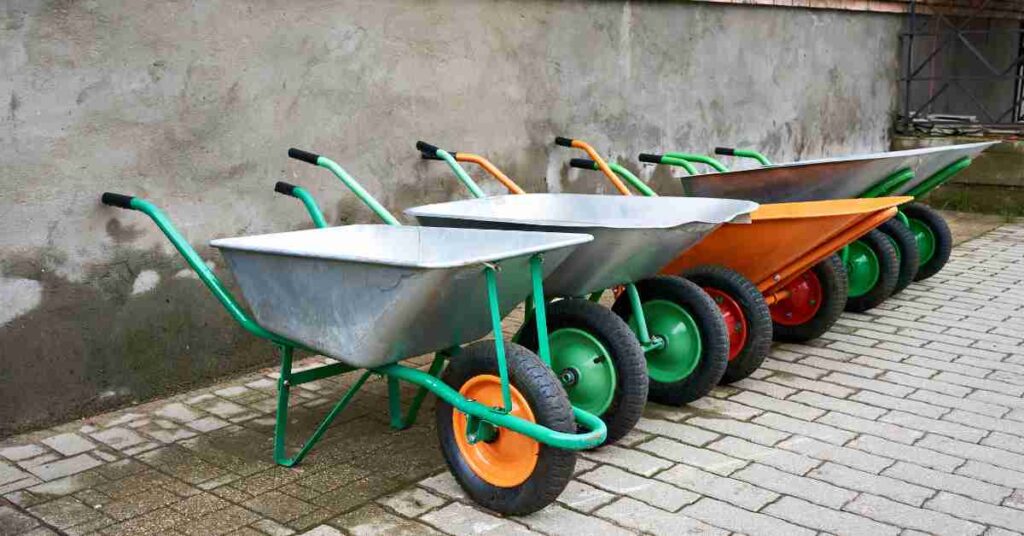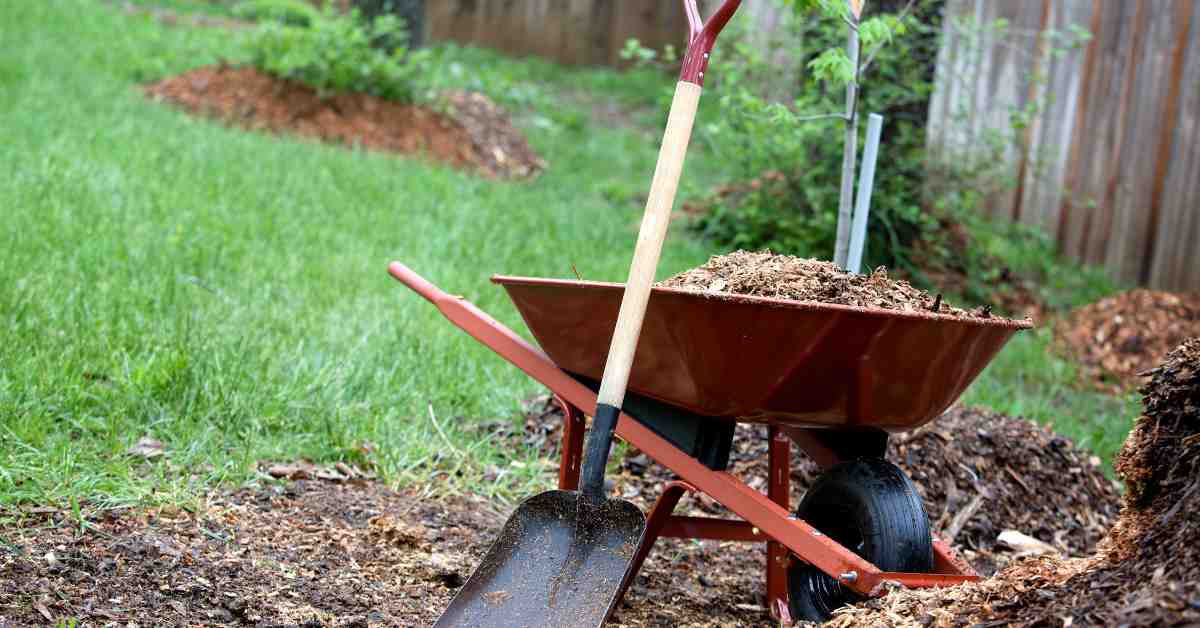When it comes to how to choose a wheelbarrow, understanding your specific needs is key.
Selecting the right wheelbarrow is crucial for gardeners, construction workers, and homeowners.
Whether moving soil, transporting plants, or hauling bricks, the right wheelbarrow can significantly impact your work’s efficiency and ease.
- Buying Guide To Choose A Wheelbarrow-
This comprehensive guide is designed to navigate you through the process, ensuring you make an informed decision that aligns perfectly with your requirements.
Buying Guide To Choose A Wheelbarrow-
Step 1: Determine the Wheelbarrow Type
Start with the Basics: Before diving into specifics, decide on the type of wheelbarrow that suits your needs. Each type has its advantages and is suited to different tasks and environments.
- Traditional Wheelbarrows: Ideal for general gardening and light construction. Their single-wheel design offers agility and precision in tight spaces but requires a good balance.
- Two-Wheeled Models: Perfect for heavier loads and uneven terrain, offering stability that the traditional design can’t match. However, they might be a bit cumbersome in very confined areas.
- Garden Carts: If you’re facing the heaviest of loads or need the utmost in stability, a garden cart with four wheels and a pull handle is your best bet. Though not as nimble as their wheeled counterparts, they excel in carrying loads with minimal effort across flat surfaces.
Step 2: Assess Capacity and Volume
Match to Your Needs: Consider the typical load you’ll be carrying. The volume of the wheelbarrow’s bucket will determine how much you can transport in one go, while the load capacity will ensure you don’t overburden your equipment.
- For light gardening, a 2 to 3 cubic feet volume might suffice.
- For larger projects or heavy materials, look for something in the range of 4 to 6 cubic feet.
Step 3: Select the Right Material
The material of your wheelbarrow—both the tray and the frame—plays a significant role in its durability, weight, and suitability for different tasks.
- Plastic Trays: Typically made from polyethylene, plastic trays are lightweight and resistant to corrosion, making them ideal for gardening tasks such as transporting mulch, leaves, or compost. However, they may not be the best choice for transporting sharp objects like branches or heavy materials like rocks, as they can crack under extreme pressure. A typical plastic garden wheelbarrow might have a load capacity of around 200-250 pounds.
- Metal Trays: Often made of steel, metal trays are the go-to for heavy-duty work. They can handle a greater variety of materials, including sharp debris and heavy loads like bricks or large stones. A steel wheelbarrow can usually carry between 300 to 600 pounds, depending on its construction. The downside is their susceptibility to rust, so look for models with a rust-resistant coating to extend lifespan.
Frame Material:
- Wood Frames: Provide a classic look and are relatively lightweight, but they require maintenance to prevent rot and may not support as heavy a load as metal frames.
- Steel Frames: Offer the highest durability and load capacity, ideal for construction projects or heavy garden work. They can typically support up to 400 pounds or more, depending on the design.
- Aluminum Frames: Strike a balance between lightweight and durability, resistant to rust, and easier to maneuver than steel, but might not support as heavy loads, usually maxing out at around 300 pounds.
Step 4: Tire Type

The choice between pneumatic and solid tires can impact maneuverability and ease of use:
- Pneumatic Tires: These air-filled tires act as shock absorbers, making them ideal for uneven terrain. For instance, a wheelbarrow with a 16-inch pneumatic tire can smoothly navigate over rocks and roots, reducing the effort required to push heavy loads. However, they are susceptible to punctures, which could be a concern in areas with sharp debris.
- Solid Tires: These tires don’t offer the same cushioning as pneumatic ones but eliminate the risk of flats. This can be particularly beneficial in environments where sharp objects, like construction nails or thorns, are prevalent. While they may make for a bumpier ride, their reliability in tough conditions is a significant plus.
Step 5: Consider Ergonomics
Ergonomics can significantly reduce strain and increase efficiency:
- Handles: Ergonomic handles, often with a padded grip, can reduce hand fatigue and blistering during prolonged use. Adjustable handles that can be tailored to the user’s height are another feature to consider, enhancing comfort and control.
- Weight: The overall weight of the wheelbarrow impacts its ease of use. For example, a lightweight aluminum wheelbarrow might weigh approximately 20-30 pounds empty, making it much easier to maneuver and lift than a heavier steel counterpart, which can weigh over 50 pounds.
Step 6: Assembly and Storage
Convenience and space-saving features are important for many users:
- Assembly: Some wheelbarrows come ready to use, while others require assembly. A kit might include several parts and fasteners, with assembly times ranging from 30 minutes to an hour, depending on complexity and tools required.
- Storage: Folding wheelbarrows are an innovative solution for those with limited space. For instance, a collapsible model can reduce its storage footprint from 58 inches in length to just 20 inches, making it ideal for small sheds or garages.
Step 7: Price and Warranty
- Price: Prices can vary widely based on material, capacity, and brand. A basic plastic garden wheelbarrow might cost between $90 to $150, while a heavy-duty steel model designed for construction work could range from $150 to $300 or more.
- Warranty: Look for products with a warranty that covers defects in materials and workmanship. A standard warranty might last for one year, but some manufacturers offer extended warranties of up to 5 years or more, reflecting confidence in their product’s durability.
Step 8: Single, Double, or Four Wheel. Which one to choose?
Wheelbarrows come in various configurations: single, double, or four wheels, each with unique benefits.
Single Wheel: Models like the Ames True Temper Steel Wheelbarrow offer exceptional maneuverability and are perfect for navigating through tight spots. The trade-off is that they demand more balance and may tip over under heavy loads or on uneven ground.
- Pros: Agile, ideal for confined spaces; lightweight and compact.
- Cons: Demands balance, particularly with heavy loads; risk of tipping on uneven ground.
Double Wheel: Offering enhanced stability, double-wheel wheelbarrows like the Jackson M6T22 Steel Tray make transporting heavy loads easier. The weight is more evenly distributed, minimizing the risk of tipping. However, their wider base can make tight spaces more challenging.
- Pros: Increased stability, lower tipping risk; better for heavy loads.
- Cons: Less nimble in tight spots; needs more storage space.
Four Wheel: For the utmost in stability, garden carts like the Gorilla Carts GOR4PS are unbeatable. Designed for heavy-duty hauling, they support large loads with ease. While they offer maximum stability, their size can make maneuvering in confined areas difficult and require more storage space.
- Pros: Maximum stability for heavy loads; supports those with balance concerns.
- Cons: Challenges with tight spaces; larger storage footprint.
Step 9: Research and Reviews

Real-world experiences can guide your final decision:
- Reviews: Look for patterns in reviews that speak to durability, ease of use, and customer service. Despite a higher price point, a wheelbarrow with consistently high ratings for its ergonomic design and durability might offer better long-term value than a cheaper, less durable option.
- Data and Stats: Pay attention to statistics like the percentage of users who recommend the product or rate it above a certain threshold. For example, a wheelbarrow that has 95% 4-star and above reviews on a reputable retailer’s website is likely a safe bet.
For the most trusted review from a cart expert, Daniel White you can take advice from our website, Wheels For Greens.
Conclusion-
Follow these detailed guided steps on how to choose a wheelbarrow.
You’re equipped to choose one that meets your current needs and will serve you well into the future.
Remember, investing in quality and suitability for your specific tasks will yield the best returns regarding productivity and satisfaction.

